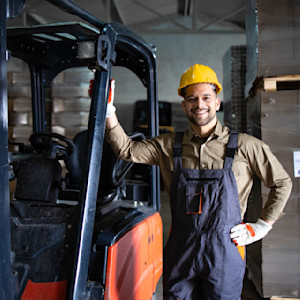Forklift Anatomy Explained: Frames, Forks and Powered Systems
Written by Staff Writer | Edited by Michael Purser

Warehouses, construction sites, ports and factories rely on these vehicles to move materials. Here’s how a forklift is built and how its major assemblies work together. This guide highlights the systems that make a powered industrial truck (PIT) move.
How Do They Work?
A lift truck is a carefully engineered machine that requires interdependent mechanical systems. These systems must all function together to safely raise and transport pallets and other materials.
What Are the Critical Components and Functions?
Let’s break down the core pieces and accessories.
Truck Frame
This component supports the weight of the operator, load, mast and all other systems. Because it bears so much stress, it is built from heavy-duty steel to withstand years of use. A warped or damaged frame can compromise the whole vehicle because the alignment of all other components depends on this sturdy foundation.
Mast
The upright metal frame at the front provides the support needed to hoist cargo. Rails, chains and hydraulic rams move the carriage smoothly. Two-stage and three-stage designs use telescoping sections to extend height while keeping the truck compact enough to fit through doors. Chains inside the rails guide the carriage as it is raised and lowered.
Forks and Attachment Parts
Tines are the technical name for the steel blades that slide under a pallet and mount to the carriage. The spacing can be adjusted for wider or narrower materials.
Tine lengths and profiles vary. Operators can also swap in various attachments, including clamps, side shifters or rotators for specialized tasks.
Overhead Guard
OSHA requires a protective structure above the seat to help keep operators safe from falling objects. This structure is usually a simple metal mesh or a similarly sturdy roof.
Counterweight
Because of the extreme loads placed far in front of the vehicle, far from the PIT’s center of mass, every forklift needs a counterweight. The counterweight is a heavy cast iron block mounted at the rear of the vehicle that balances the load on the forks to prevent tipping.
They’re critical components for safety, especially since tip-overs are among the most common accidents involving forklifts.
The Power and Motion Systems
Next, let’s review the systems that power these machines.
Hydraulic System
Hydraulics are the powerhouse of the lifting system. Pressurized fluid moves through hoses to hydraulic cylinders, which extend to push the mast up and raise the forks.
When the operator lowers the forks, hydraulic fluid flows back into the reservoir. Any leaks in the hydraulic system can reduce the lift's power or even create slipping hazards as fluids spill onto the floor.
Smaller hydraulic cylinders, called tilt cylinders, angle the mast forward or backward to stabilize loads and improve handling during lifting and stacking.
Engine or Electric Motor
Designs may be powered by internal combustion engines run on liquid petroleum gas (LPG), gasoline or diesel, or by rechargeable electric batteries. Combustion engines provide more power for outdoor or heavy-duty use, while electric motors are cleaner and quieter for indoor environments.
Steering System
Unlike cars, industrial trucks use rear-wheel steering. This design allows for sharp turns even in tight warehouse aisles, but it also means the rear swings outward during turns and can be challenging — especially for newer operators.
The steering system includes the steering wheel, axle and linkages that control the wheels.
Drive axles are sturdy steel supports that transfer power from the engine or motor to the wheels, propelling the vehicle forward or backward. Steer axles are positioned at the back of the lift and pivot for tight turns in narrow spaces.
Transmission and Brakes
The transmission turns power from the engine into motion for the drive wheels, allowing operators to move forward or backward. Brakes stop the vehicle by applying pressure to the wheels. Because these machines typically carry heavy materials, powerful, reliable brakes are essential to bring the machine to a halt to prevent accidents.
Operator Controls and Safety Mechanisms
The operator’s compartment is where warehouse safety and control come together.
Like most vehicles, the control position (either a seat or a stand-up design) places drivers in front of a steering wheel, accelerator, brake and directional control levers to maneuver. In addition to the usual driving controls, forklift operators must keep an eye on the instrument panel, which includes fuel/battery levels, warning lights, speed limiters and electronic stability controls.
Finally, the control panel is home to one or more levers that control the height, position and tilt of the forks.
Seat belts and restraint systems help with driver safety in case of a sudden stop, collision or tip-over. Wearing a seat belt at all times, even for short operations, can prevent some of the most common forklift injuries.
Modern models may also include electronic stability controls and speed limiters.
When used properly by trained operators, these features work together for safe and efficient operation.
Get the Training and Certification to Operate Safely
Whether you’re using a traditional forklift, a scissor lift, aerial lift equipment or even a telescoping boom lift, training helps you handle loads more smoothly, reducing the chance of dropping materials or damaging products.
We offer convenient courses for PIT and heavy equipment operators. All are available 100% online and can be taken from any internet-connected device.
Log in and out at any time without losing your progress. Fit training into your busy schedule and learn at your own pace. Our courses teach all the required safety concepts to prepare you for the hands-on evaluation employers must provide to complete certification.
Once you complete the coursework and evaluation, your certification will remain valid for three years. Get started today!
